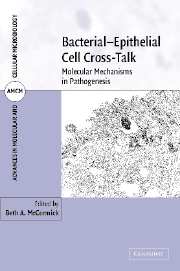Book contents
- Frontmatter
- Contents
- List of contributors
- Part I Introduction to the host and bacterial pathogens
- Part II Bacterial cell biology and pathogenesis
- Part III Host cell signaling by bacteria
- Part IV Exploitation of host niches by pathogenic bacteria: mechanisms and consequences
- 11 Lung infections
- 12 Interaction of Helicobacter pylori with the gastric mucosa
- 13 Interactions of enteric bacteria with the intestinal mucosa
- 14 Uropathogenic bacteria
- Index
- Plate section
- References
14 - Uropathogenic bacteria
from Part IV - Exploitation of host niches by pathogenic bacteria: mechanisms and consequences
Published online by Cambridge University Press: 12 August 2009
- Frontmatter
- Contents
- List of contributors
- Part I Introduction to the host and bacterial pathogens
- Part II Bacterial cell biology and pathogenesis
- Part III Host cell signaling by bacteria
- Part IV Exploitation of host niches by pathogenic bacteria: mechanisms and consequences
- 11 Lung infections
- 12 Interaction of Helicobacter pylori with the gastric mucosa
- 13 Interactions of enteric bacteria with the intestinal mucosa
- 14 Uropathogenic bacteria
- Index
- Plate section
- References
Summary
INTRODUCTION
Urinary tract infections (UTI) are among the most common human bacterial infections. The prevalent pathogens are the uropathogenic Escherichia coli (UPEC) strains. A great deal of information concerning the genetic, virulence, and innate immune host responses against those bacteria have been obtained. Furthermore, the knowledge of uroepithelium cell biology and physiology, in particular at the level of the urinary bladder, has made considerable progress since 1995, improving our understanding of the strategies used by UPEC to colonize and invade this tissue.
UTIs account for significant morbidity and high medical costs. In 1997, the National Ambulatory Medical Care Survey and the National Hospital Medical Care Survey Report estimated that UTIs in the USA result in nearly seven million doctor visits per year, excluding visits to hospital emergency departments. The overall costs associated with UTIs have been estimated to reach upwards of two billion US dollars a year (Foxman, 2002). Moreover, nosocomial acquired urinary tract infections (NAUTIs) account for up to 40% of all hospital-acquired infections in European countries and represent the most frequent nosocomial infection (Eriksen et al., 2004; Johansen, 2004; Zotti et al., 2004). NAUTIs, which are frequently associated with medical procedures (the most important risk factor being an indwelling catheter), may result in significant acute morbidity, medical complications, and legal issues (Johansen, 2004). Moreover, one of the main concerns with UTIs is that they are frequently sources of recurrent infections.
The severity of UTIs depends on the spread of the infection.
- Type
- Chapter
- Information
- Bacterial-Epithelial Cell Cross-TalkMolecular Mechanisms in Pathogenesis, pp. 400 - 422Publisher: Cambridge University PressPrint publication year: 2006



